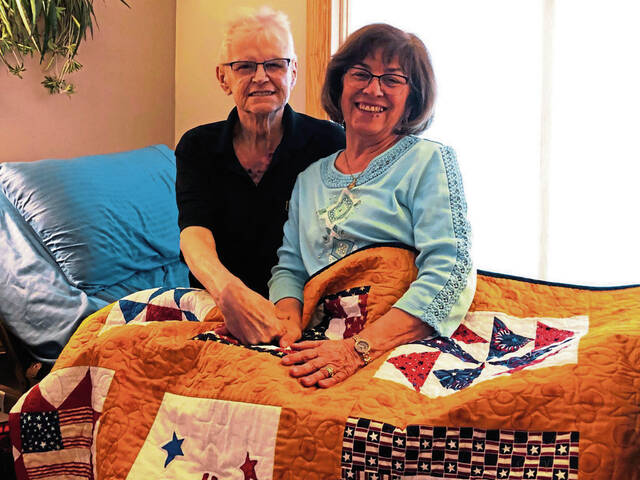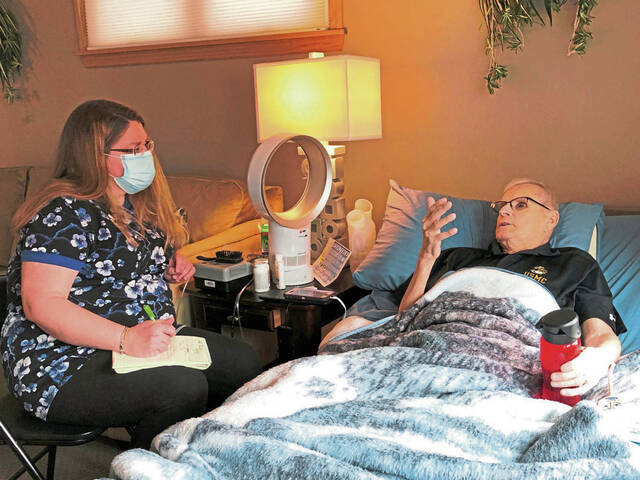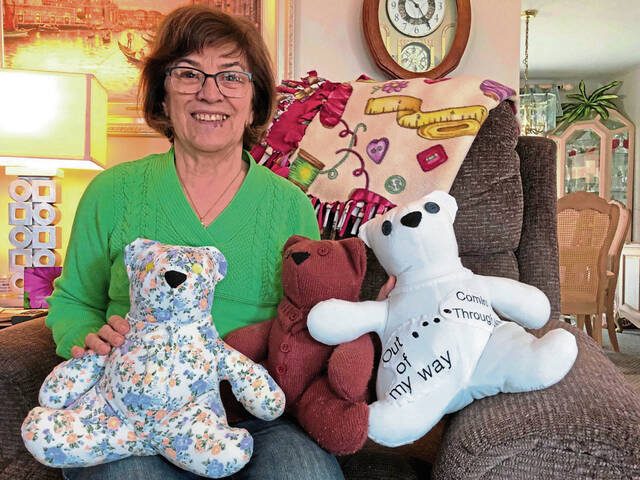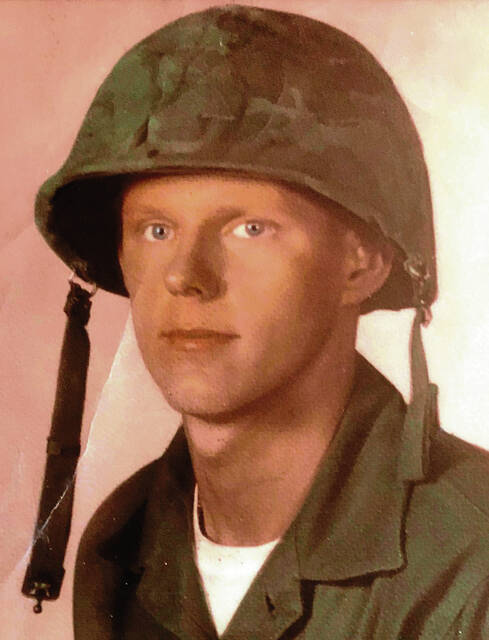Lower Burrell Marine tells the story of his life while he still can
Hal Shaffer is ready to die.
“I’ve had so much pain and suffering in my life, I’m ready to go,” Shaffer, 74, said from the hospital bed in the living room of his Lower Burrell home with his wife, Dee, beside him.
A Marine Corps veteran who survived a grenade explosion in Vietnam, Shaffer has endured four types of cancer, and the grueling radiation and chemotherapy treatments that followed, and is now terminal.
If not for his wife of nearly 27 years, Shaffer confesses he probably would have killed himself to escape the pain.
“I feel sorry for Dee,” he said. “She’s the only reason I wanted to live since I met her.”
Believing there’s a reason for everything, Dee Shaffer, 75, said Hal is leaving her slowly because he wants to make sure she is taken care of, and that she’ll be OK after he’s gone.
“We’ve kind of learned to accept his fate, but, every once in a while, it will hit you,” she said. “I’ve never lived by myself. This is all going to be new to me.”
Dee was after Hal to write a book about his life and experiences in the military. She volunteers at Heritage Hospice in New Kensington, where she knows Lauren Athey Penrose, who works as a hospice music therapist. Penrose suggested they do audio recordings of Hal telling his stories for his family.
Penrose said it’s called “legacy work.”
“Some folks have a need to make sure that their story lives on past the time of their dying,” she said, adding that men do it more than women. “A lot of men want to walk through their life again. Sometimes it’s just helpful for families to hear their loved one’s voice after they pass. It’s a keepsake. It’s something for posterity; they can always have a connection to their loved one.”
In her first session with Hal, he talked about how he became a Marine. In a second on Friday, they covered his life after Vietnam, including his first wife and meeting Dee.
“What has been really important to Hal is people have an understanding of what he went through when he was in the war,” Penrose said. “It’s an amazing story and one worth hearing.”
A native of the Pulaski area north of New Castle, Hal came to live in the Pittsburgh area with his first wife after being discharged from the Marines and getting a job with Medrad, where he worked for 34 years.
Dee was born in Oakmont and grew up in the New Kensington area. Her marriage to Hal is the second for her, too.
Hal has a son from his first marriage. Dee has a daughter and son from hers. And they have three grandchildren.
Although they were both bowling at the same alley in Harmar, that wasn’t where they met. They met at a bar they would both go to afterward, when Hal said a buddy he was with suggested they ask a couple of women, one being Dee, if they would like to dance.
“We just hit it off,” Dee said.
They started dating in the mid-1980s but didn’t get married until 1995.
“We dated that long because I think we were both hesitant about getting married again, because we both had one fail,” Hal said.
Semper Fi
A self-described “country boy,” Hal enlisted in the Marines while he was still in high school, graduating in 1967.
“I felt it was an honor to live in this country. I felt it was a duty” to enlist, he said. “To me, there’s no other better country in this world. We may have problems, but everybody does.”
Knowing he would join the military and with no intention of ever going to college, Hal said he didn’t focus on academics in high school.
Hal said he chose the Marines over other branches because of their credo that they never leave anyone behind.
He learned the credo’s real meaning a year later.
Hal left for boot camp shortly after graduating from high school in June 1967. He was in Vietnam in November that year, and the Tet Offensive began in January 1968.
“There wasn’t a day that went by we weren’t shot at, or mortared or attacked,” he said.
It was 1 in the afternoon on June 14, 1968, that Hal would be wounded so badly that some believed he had died.
Hal was the squad leader of a five- or six-man group that was on a patrol south of Da Nang on that hot, muggy day. They were making their way through knee-high weeds when the point man a few feet in front of him hit a trip wire, setting off a grenade.
“It was like everything was in slow motion,” Hal said. He remembers lying in a hole, covered in blood, looking up at the sky.
“I thought: ‘This is it, I’m done,’ ” he said.
An ambush followed. The others in his squad who were able to fight were shooting back, protecting him.
Hal was in danger of bleeding to death. When the pilot of a helicopter said he didn’t want to land to pick Hal up, a platoon radio operator told the pilot he’d order his men to shoot him down if he didn’t — Marines don’t leave anyone behind.
The blast put shrapnel and dirt throughout Hal’s body, blew off the tip of his nose and tore out his left eye. He lost part of his lower bowel and severed a vein in his left leg.
He’d later learn that a cut to an ear was from a piece of shrapnel that ricocheted off a necklace he was wearing; if not for the necklace, the shrapnel would have severed his jugular and he surely would have died.
Hal was wearing a flak jacket that day. He said they often didn’t, but an officer they were with required it.
After being transported to several locations for surgeries and care, including the hospital ship USS Sanctuary and Tokyo, Hal ended up at Bethesda Naval Hospital in Maryland. He went home to his parents, and was discharged in December 1969.
He received the Purple Heart and was classified as fully disabled.
With his plans to become a police officer after his military service no longer possible, Hal went to college after all, earning a two-year degree from Penn State in 1972. He’d work in manufacturing for Medrad from 1973 to 2007.
A legacy of war
His health problems began in 2006, when he had the first of four heart attacks and was diagnosed with Type 2 diabetes.
Hal said he was exposed to Agent Orange, a tactical herbicide used to clear leaves and vegetation, in Vietnam. He said it’s the cause of the cancers he has suffered — prostrate, lymphoma, lung and thyroid.
After enduring years of treatments, including a clinical trial, Hal was told in October that nothing more could be done for him. He went into hospice care.
Dee has been volunteering with Heritage Hospice for a decade. In addition to helping in the office, she has used her sewing skills to make “memory bears” — made from a deceased person’s clothing and given to their survivors as a comforting keepsake.
“Every once in a while, I’ll get a card thanking me,” she said. “I don’t care about that. I’m just happy it means so much to them.”
Dee has no idea how many bears she has made. She has made a few for herself, including one from her mother’s sweatshirt and another from her mother-in-law’s blouse.
She said she’ll likely make one with a piece of Hal’s clothing.
“I’d probably do it and cry the whole time,” she said.
Hal said he has enjoyed telling his life stories to Penrose and doesn’t mind talking about his service. While many veterans don’t like talking about their war experiences, Hal thinks how he returned made a difference.
“I came back slowly into the States,” he said. “It was a cultural shock for those that came back quickly. I came back slowly.”
Penrose said Hal told her he’s never felt as appreciated for his service as he does now, in his final days.
“That breaks my heart,” she said. “He suffered so much. But he’s very proud to be a Marine, and he would do it all over again.”
Having listened to Hal, Penrose said she has felt like she’s in the presence of a hero.
“What struck me the most is the miraculousness of his survival. The fact that Hal is alive is absolutely incredible,” she said. “When you consider everything that happened to him, it’s an amazing story to hear.
“I asked him what he thought he learned from that. He said, ‘When it’s your time to go, it’s your time to go.’ You don’t really get to pick it. It just happens.
“Because of that, he’s never had any fear.”
It’s not clear how many more sessions Hal will have with Penrose. “It depends on how long he lasts,” Dee said.
Dee said she’ll probably listen to Hal’s recordings, sometime after the initial shock of his death subsides.
Harold “Hal” Shaffer will be buried at Greenwood Memorial Park in Lower Burrell.
Brian C. Rittmeyer is a TribLive reporter covering news in New Kensington, Arnold and Plum. A Pittsburgh native and graduate of Penn State University's Schreyer Honors College, Brian has been with the Trib since December 2000. He can be reached at brittmeyer@triblive.com.
Remove the ads from your TribLIVE reading experience but still support the journalists who create the content with TribLIVE Ad-Free.




